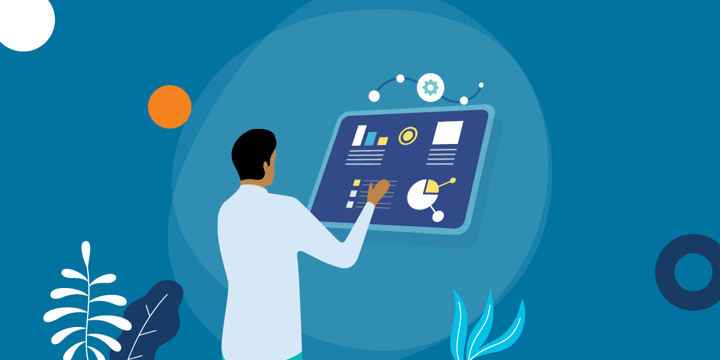This blog post is more than five years old. It may contain outdated information or refer to products that are no longer available.
Samantha Barnard, deputy director of Phambano Technology Development Centre on M&E, is a globally recognized expert with firsthand experience of how nonprofits at all scales can tap into the benefits of monitoring and evaluation. Here are her tips for up-leveling your M&E strategy.
What Is M&E?
Monitoring and evaluation (M&E) is a strategy deployed by many social impact and community organizations today to drive better outcomes through continuous data-based assessments. While the goals of nonprofits vary, they typically use M&E to systematically improve project performance, management, and organizational oversight.
M&E insights can showcase impact for activities such as grantseeking and stakeholder engagement, as well as boosting internal collaboration.
The difference between monitoring and evaluation is the time when they take place. Monitoring takes place during the implementation of an activity, while evaluation occurs after a specific set of activities. Monitoring is used to gauge effectiveness on a short-term basis, such as improving daily project management. Meanwhile, evaluation is used to determine whether core objectives are being met.

Why Is M&E Important?
Nonprofits use M&E in different ways, including driving better decision-making, creating a more sustainable business model, and attracting more funding resources and impact capital. M&E can also assist nonprofits with scaling their volunteer-led programs and expanding partnerships.
Typically, an organization first determines its exact level of digital readiness and then chooses a mix of tools and services to accomplish its M&E goals.
Setting Up an M&E System
The first step of creating an effective M&E system is aligning organizational goals with those of core stakeholders. Depending on the scale and scope of an organization, M&E objectives can be determined internally or with external consultants.
However these goals are developed, organizations should clarify what milestones they would like to achieve through M&E and map out a work plan. A point person should be assigned to facilitate seamless communications and data gathering for all critical sources of information.
Choosing the Right M&E Tools
The second step of M&E is choosing tools to collect data and develop impact reports. Think beyond just data collection. M&E is really a continuous process that requires learning and behavior to become engrained across all lines of operation.
This means that you should have (1) a solid data strategy and (2) adequate training and expertise to use learnings from data collected.
Organizing Data in the Cloud
As much as possible, eliminate habits that will compromise the integrity of data. Paper-based data collection should be avoided at all costs. Opt for cloud-based data collection or offline data collection applications and conversational SMS forms in situations where Internet access is nonexistent.
A good M&E program is not just documenting activities, but working with practitioners to measure and act on living, breathing processes. Cloud collaboration tools can help you
- Ask who the point persons are in any process
- Identify key functions and activities that could be improved
- Determine the depth and scale of your social impact
- Mitigate areas of risk
Visualize Those Insights
When choosing cloud-based tools for reporting, make sure that data analytics can be as tightly integrated as possible with visualization tools. The more seamless the flow of information is, the more time personnel can spend on serving stakeholders.
Check out these offers from TechSoup for mapping, charting, and securely storing data.
Here are some popular data charting tools:
- Microsoft Excel (through TechSoup)
- Adobe Illustrator (through TechSoup)
- Adobe Photoshop (through TechSoup)
- Google Charts
When designing any data strategy for M&E, keep in mind that the ultimate goal is not data collection itself — it is aligning measurable and actionable insights with your theory of change.
Start by building out a central repository or unified data warehouse. The more consistent the data collected is, the more accurate and actionable the findings will be.
Align Results with Reporting
The beauty of a single source of truth for M&E data is that you can develop a variety of integrations. And as your needs scale, a unified location for all information gathered means more time for personnel to focus on what matters most — using M&E data to increase the effectiveness of their work.
Rather than letting the data "speak for itself," make sure that reports are being built out for specific audiences. For example, external funders may have different questions and expectations around M&E insights than internal project managers.
Reporting functions should be accurately timed per the needs of stakeholders. With real-time reporting via tools such as Tableau and Power BI, organizations can avoid the inconsistencies and inaccuracies when managing data via paper or spreadsheets.
Common Questions Around M&E
- Am I ready for M&E? Yes, but not as ready as you may think. When collecting raw data for M&E analysis, nonprofits may choose tools that are more sophisticated than what their team needs. Bespoke solutions are really designed for organizations that work at a large scale, and a simple logical framework (also known as a "logframe") might do the trick initially. A logframe is a simple chart that breaks down your project objectives and the specific resources needed to execute your goals. Here is a handy logical framework template.
- How much will it cost? As M&E needs scale, the total cost of infrastructure must be taken into account to avoid breaking the bank. Along with the baseline cost of new tools, nonprofits may need to hire specialists and consultants to set up and help staff get up to speed with new systems. Prioritize deliverables such as impact reports and metrics for grants and external funding before investing in customized solutions.
Upgrading and Scaling Your M&E System
M&E should be seen as a daily task for nonprofits; however, the thought of continuous data collection often overwhelms. When nonprofit organizations digitally transform their day-to-day activities, donor, beneficiary, and stakeholder relationships increase.
This should be a consideration for all nonprofits when deciding on M&E tools and systems as the increase in communication, reporting, and funding will need to be welcomed by the entire team.
Your M&E systems and approach should be upgraded at least once, and in some cases twice, every year (depending on the overall digital maturity of your organization). To ensure seamless operations, empower multiple workers within an organization to get involved and offer feedback on the process.
The three main areas M&E can streamline are fundraising, volunteer operations, and finance. Here at Phambano, the ultimate success of our M&E lies with the people who are using digital systems to capture data. Therefore it is important for nonprofits, charities, and civil society organizations to touch base regularly with each division, department, and stakeholder. This will translate into better M&E outcomes — from data collection and surveys to overall program planning, policy, and everyday practices.
You can, for example, leverage an upgraded M&E framework for social media marketing and engagement. Using data to inform these activities can assist your nonprofit in better understanding target audiences, donor behavior online, and content types that are best suited to your brand and messaging.
And by using this information, you can routinely scale up offline relationships with major donors and local communities, as well as retaining and further engaging beneficiaries to achieve greater social impact.
Effective M&E practices afford your nonprofit the opportunity to continuously assess social impact, so, as your programs evolve, your M&E systems, tools, and techniques should too!
What's Next in M&E?
Data collection is often touted as a huge challenge when it comes to M&E, but nonprofits today also struggle with an emphasis on activity-based reporting — often overlooking key outcomes (the core aspects of impact management).
When you invest in any measurement and reporting tool, ensure that the methods used align with your organizational objectives and that they address stakeholder needs. The core of effective data analysis is to dive deeper into baseline findings, uncovering multiple layers of information past the question level.
Emerging innovations such as the Internet of Things and machine learning are also helping to boost M&E data accuracy and interoperability — allowing for different streams of information to be more easily aligned with core program requirements.
Whatever your level of knowledge about M&E is, TechSoup can help you leverage it to achieve greater social impact.
Additional Resources
- Sign up for TechSoup Courses' Nonprofit Data and Impact Measurement Mega-Pack and Excel for Nonprofits track.
- Learn about Digital Transformation: What It Means for Your Nonprofit and How to Get Started.
- See how to Power Up Your Organization's Data with Microsoft's Power BI.
- Watch a webinar on How to Collect, Analyze, and Share Program Impact Data.








